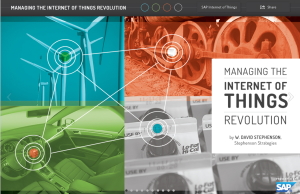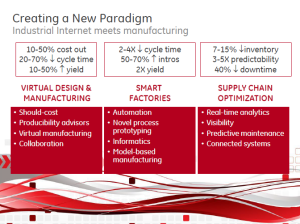Greg Gorbach, ARC Advisory Group, Industrial Internet of Things:
- ARC is an analyst firm, in Boston.
- new service models
- new products
- new production techniques
- new business processes
- new competitors
- new partners
- new workers
- new business opportunities.
- innovation improves competitiveness: value-based competitiveness raises value of output.
- Drivers:
- reduced machine or asset downtime
- more rapid service response
- improved process performance
- improved personnel productivity
- reduced machine or asset lifecycle costs
- improved asset utilization/RoA
- opportunity for business innovation
- ability to sell products as a service
- manufacturing momentum for digital transformation: factors include 3D printing, IoT technologies, changing economies of scale, new service models
- goal is digital transformation
- software transitioning from monolithic to microservices
Richard Howells, SAP:
- IoT is all about re-imaging things:business process, customer experiences
- SAP solutions for IoT
- SAP Connected Assets
- SAP Connected Manufacturing
- SAP Network Logistics Hub
- SAP Augmented Reality Solutions
- SAP Predictive Maintenance and Service: leverage operational insights to drive innovation & new business models
- Deere putting sensors everywhere, doing predictive maintenance of tractors. In some cases, leasing instead of selling, so they have incentive to keep it operating.
- Kaeser Compressors
- Asset Intelligence Network
- Connective Manufacturing: leveraging big data to drive new insights into operations.
- Example of Harley Plant in York, Pa. Many new design options (1,700 options), but do 25% more bikes with 30% fewer people. Went from 21 days for a custom cycle top 6 hours.
- Pepsi: improving asset utilization with SAP Connected Manufacturing: collect all downtime and loss data in real time. Went from 65 to 85% asset use.
- SAP Networked Logistics Hub
- SAP AR Warehouse Picker
- SAP AR Service Technician
Where is IoT going??
- 68% of companies see IoT being strategic or transformational to their business.
- 78% plan to invest in IoT in next 24 mo. — 24% already have.
- Increasing productivity and improving customer experience are top business benefits
- Challenges to deploying IoT include unclear ROI, lack of industry standards, costs, and data security.
Next was my presentation on “Getting Started With the IoT,” in which I emphasized that companies that have hung back from the IoT are still in the majority, but had better heed John Chambers’ warning that they’ll be toast in just a few years if they don’t start now. I emphasized that an ideal early focus is to build the efficiency or “precision” of your existing operations, and to build operating safety (especially in inherently dangerous settings such as construction sites), then move on to more radical transformation. I cited GE’s rather modest goal (I think they’re understating it, based on their own internal results) of a 1% increase in productivity for the IoT as something that most companies could achieve, and then talked about GE’s Brilliant Factories as a model for increasing operating efficiency, zeroing in on my favorite example, the Durathon Battery plant, where a sensor on every battery and 10,000 on the assembly line give them tremendous flexibility to cope with differing situations and to increase efficiency. Finally, I suggested that the companies begin to rethink the role of their products and to begin considering the “circular enterprise” vision I’ve articulated as they look to the future.
Kris Gorrepati, SAP “IoT: from Big Data to Smart Data to Outcomes.”
- OK, I’d never heard of a Brontobyte before…
- “IoT relevant to all industries.” Agreed.
- Amazon Dash service (Whirlpool now building it in!)
- Uses same curve that other SAP guys do: from connect to transform to reimagine (latter being empowering new biz models, value-added products and services.
- HANA Cloud Platform for the IoT.
 This is an issue that I first visited with my “
This is an issue that I first visited with my “
